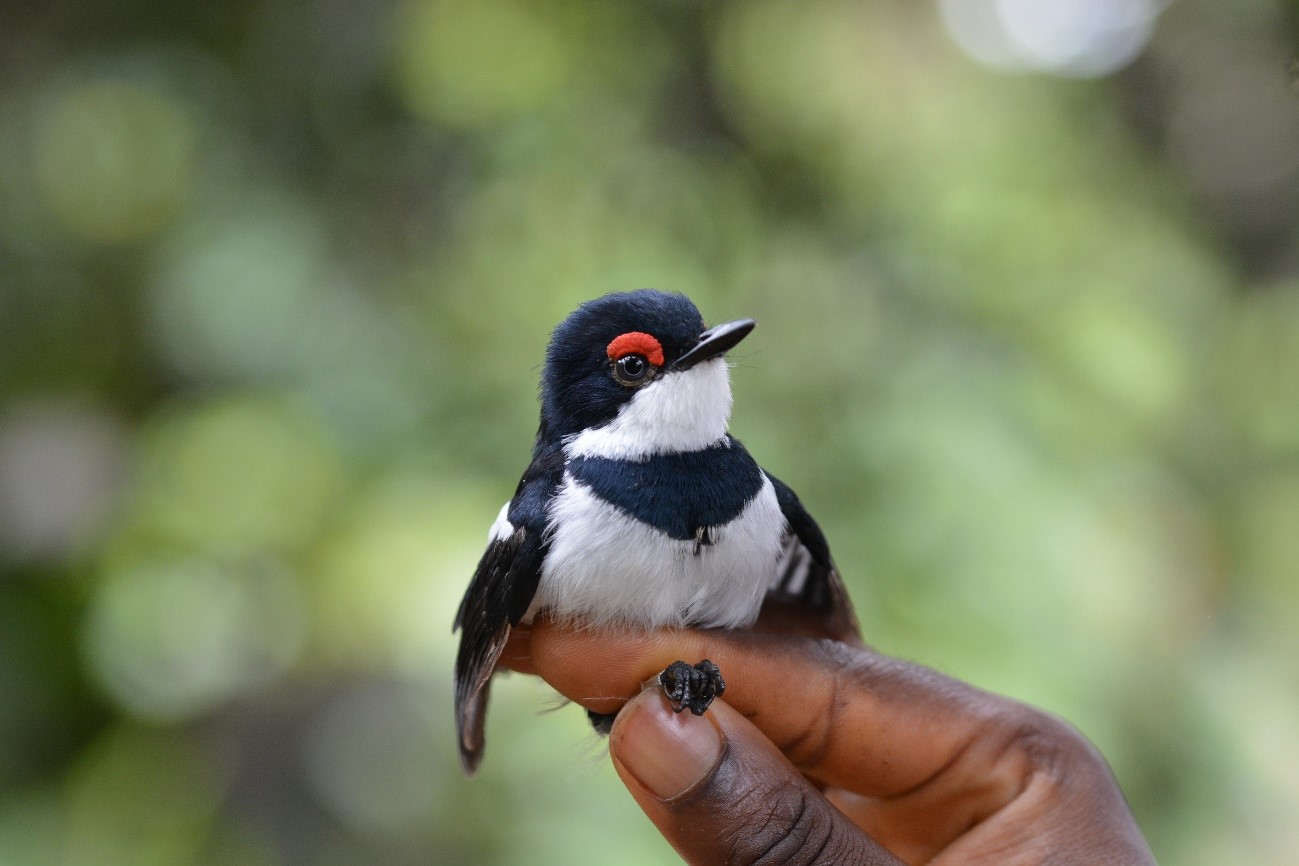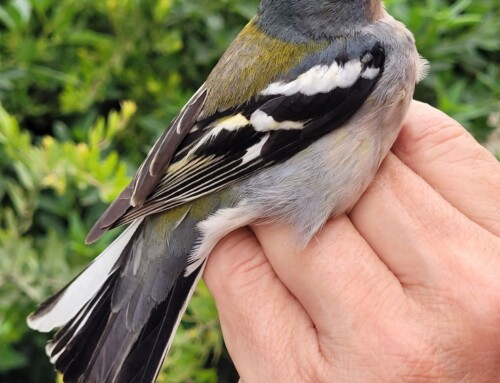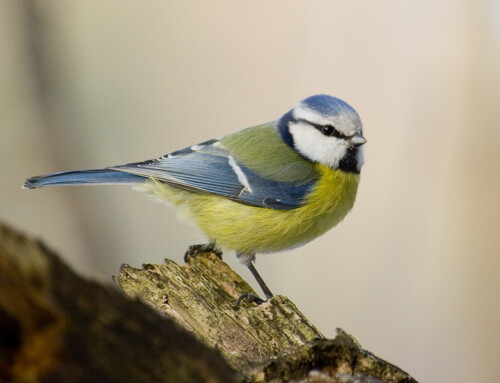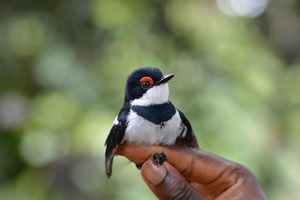 LINKED PAPER
LINKED PAPER
Birds and bats enhance yields in Afrotropical cacao agroforests only under high tree-level shade cover. Ferreira, D.F., Jarrett, C., Wandji, A., Atagana, P.A., Maas, B., Rebelo, H. & Powell, L.L. 2023 Agriculture, Ecosystems and Environment. doi: 10.1016/j.agee.2022.108325 VIEW
Across the tropics, forests are being cleared to make place for agriculture, driving declines in many rainforest taxa. However, certain agricultural practices can provide habitat for wildlife whilst at the same time generating yields and income for farmers. Agroforestry, the practice of planting crops beneath a canopy of shade trees, is one such practice, with evidence from South America and South-East Asia showing promising win-win scenarios for biodiversity and productivity (De Beenhouwer et al. 2013).
Cocoa (Theobroma cacao) is one of the most valuable tropical crops and is typically grown in agroforestry systems. About 70% of the World’s cocoa is grown in sub-Saharan Africa. Although cocoa cultivation is expanding rapidly across Africa, its productivity is decreasing in many producing countries due to problems with degraded soils, pests and diseases. Worldwide, it is estimated that cocoa pests and diseases can cause losses of more than £552 million annually.
An appealing solution to the problem of insect pests in agroforestry is biological control. We could expect that the diverse range of wildlife species able to inhabit these low-intensity cocoa agroforestry systems could provide increased ecosystem services (pest control) compared with intensively farmed agricultural habitats. However, there is limited information about ecosystem services provided by wildlife in agroforestry, especially in the Afrotropics. Here, we set out to test whether birds and bats suppressed pest insect populations in cocoa farms, using a simple experimental manipulation.

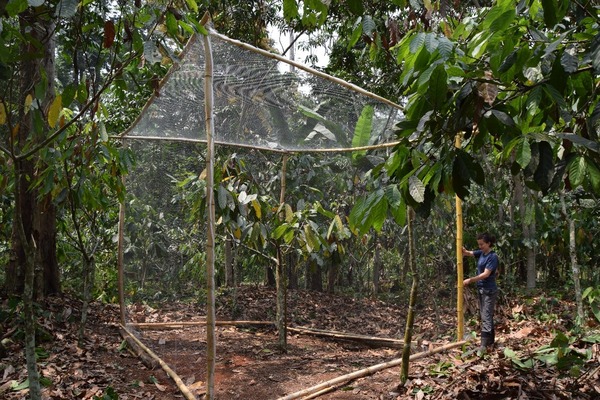
Figures 1 and 2 Top: Building an experimental exclosure in a Cameroonian cocoa farm; Bottom: Completed exclosure.
For one year, we excluded birds and bats from 16 cocoa trees by building exclosures made of fishing net and bamboo poles over them (Fig. 1). We compared these experimental trees to paired control trees, that were similar in all characteristics (age, size, variety, etc.) but were not covered by an exclosure. The 32 trees (16 exclosure and 16 control) were spread over eight farms with varying levels of shade cover. Low values of shade cover indicate more intensively managed farms, and high values of shade cover indicate low management intensity. Throughout the year, we monitored insect populations and cocoa pods once per month in experimental and control trees.
Over the whole experiment, we recorded 162,579 arthropods belonging to 17 orders. Ants (family Formicidae) were the most common group, followed by plant-sucking insects (order Hemiptera). Mealybugs were the most common pest, with 680 records in control trees and 4,967 records in exclosure trees.
We found that when birds and bats were excluded, certain arthropod groups showed significant increases in abundance (Fig. 2). Most remarkably, Mealybugs increased by ~92% in the absence of vertebrate predators, and Hemiptera by ~38%. Spiders and mantids (predatory arthropods) also increased when birds and bats were excluded, whilst social insects (Hymenoptera) were less abundant in exclosures.
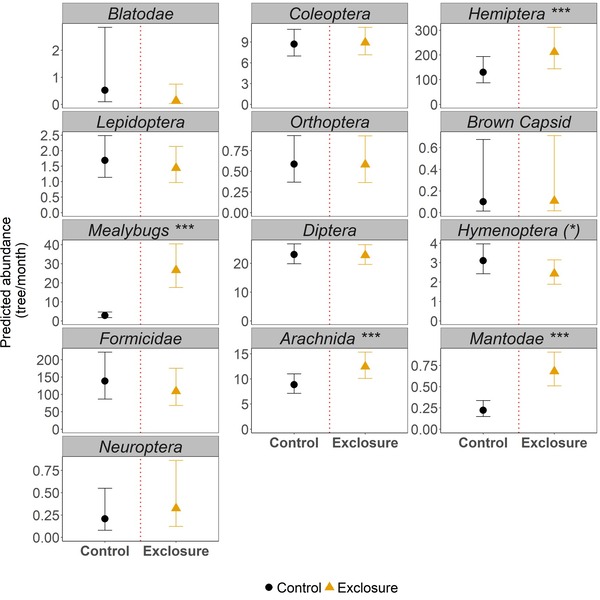
Figure 3 Effect of treatment (either Exclosure or Control) on abundance of different arthropod groups in cocoa farms. Exclosure represents trees where birds and bats were excluded, whereas Control represents trees where these groups were not excluded.
Concerning cocoa yields, we found that results were dependent on shade cover, where at high levels of shade cover (~90%) we had 3.2 times more large pods in the trees where bats and birds were not excluded, while at low levels of shade cover (~10%) we had almost 3.7 times fewer large pods.
Our results show that birds and bats suppressed important insect groups such as Mealybugs and Hemiptera. Mealybugs are responsible for carrying swollen shoot virus disease, a disease that only occurs in West Africa that can cause cocoa tree death and crop losses of several million euros. Hemipterans are sap-sucking insects with economic significance since they can be pests of various crops across the world. However, due to limited information on the pests of African cocoa, we could not distinguish between pest and non-pest Hemipterans in our experiment (aside for a limited number of groups). It seems likely that a fraction of the Hemipterans counted could cause damage to cocoa trees. Conversely, we found that birds and bats also provide a dis-service in cocoa by consuming predatory insects (evidenced by the increase in abundance of these groups inside exclosures).
Cocoa production usually decreases with increasing shade cover, with studies suggesting that 30% shade is the optimum to maintain win–win scenarios for farmers and biodiversity (Blaser et al. 2018). In our study, we recorded a constant decrease in the number of large pods with increasing shade cover in exclosures but an increase when birds and bats were present. This opposite trend of shade cover on production in exclosures and controls is hard to explain; it could be due to higher numbers of pests in shady farms causing heavy losses in exclosures. Indeed, bats and birds are known to increase productivity through pest suppression in different agroforestry systems (Maas et al. 2016), with these services being higher in plantations with high shade cover and forest proximity (Gras et al. 2016).
Other studies conducted in the same cocoa plantations showed that insectivores bats and birds increased in abundance with increasing shade cover (Jarrett et al. 2021). So, it is very likely that the differences observed in productivity are associated to pests, albeit species that we were not able to identify as such. We need more studies to know if this increase in the number of pods in control trees with increasing shade cover is associated to that or another underlying mechanism.
With the increasing demand for chocolate (mostly from countries in the Global North, including the UK and Switzerland), it is more important than ever to adopt agricultural practices that will maintain biodiversity. Understanding ecosystem services in agricultural habitats could be key to ensuring win-win scenarios between agricultural productivity and ecosystem services. Birds (and bats) may be key players in ensuring that delicious chocolate bars can stay on our tables with minimum impact on wildlife.
References
Blaser, W. J., Oppong, J., Hart, S. P., Landolt, J., Yeboah, E., & Six, J. 2018. Climate-smart sustainable agriculture in low-to-intermediate shade agroforests. Nature Sustainability 1: 234-239. VIEW
De Beenhouwer, M., Aerts, R., & Honnay, O. 2013. A global meta-analysis of the biodiversity and ecosystem service benefits of coffee and cacao agroforestry. Agriculture, Ecosystems and Environment 175: 1-7. VIEW
Gras, P., Tscharntke, T., Maas, B., Tjoa, A., Hafsah, A., & Clough, Y. 2016. How ants, birds and bats affect crop yield along shade gradients in tropical cacao agroforestry. Journal of Applied Ecology 53: 953-963. VIEW
Jarrett, C., Smith, T.B., Claire, T.T.R., Ferreira, D.F., Tchoumbou, M., Elikwo, M.N.F., Wolfe, J., Brzeski, K, Welch, A.J., Hanna, R. & Powell, L.L. 2021. Bird communities in African cocoa agroforestry are diverse but lack specialized insectivores. Journal of Applied Ecology 58: 1237-1247. VIEW
Maas, B. et al. 2016. Bird and bat predation services in tropical forests and agroforestry landscapes. Biological Reviews 91: 1081-1101. VIEW
Image credit
Top right: Common Wattle-eye (Platysteira cyanea) caught during bird surveys in a Cameroonian cocoa farm.
If you want to write about your research in #theBOUblog, then please see here.


